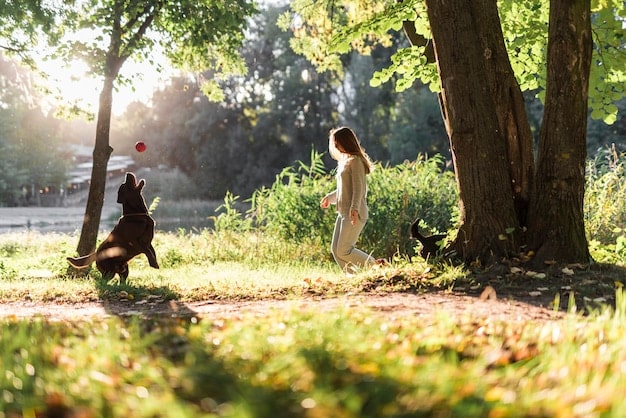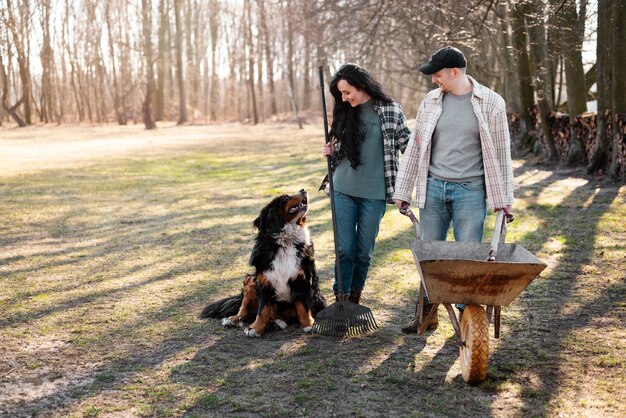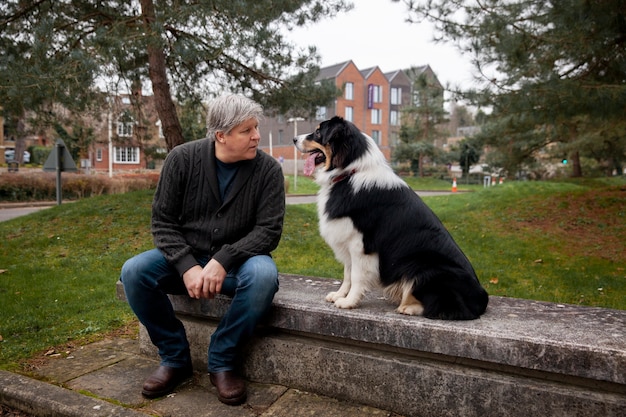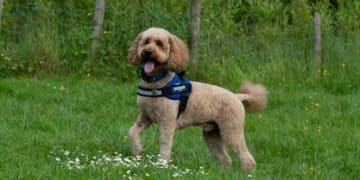Dog Park Etiquette: Teach Your Dog to Play Safe and Have Fun

Dog park etiquette involves understanding canine behavior, socialization practices, and responsible owner conduct to ensure a safe and enjoyable environment for all dogs and their owners, preventing conflicts and promoting positive interactions among pets.
Visiting a dog park can be a fantastic way for your furry friend to socialize, exercise, and explore. However, it’s crucial to understand and practice proper dog park etiquette to ensure a safe and enjoyable experience for everyone. Let’s dive into how to teach your dog to play nicely and avoid conflicts at the park.
Understanding Dog Park Basics
Before you even consider taking your dog to a dog park, it’s essential to understand the basics. Dog parks are designed to be off-leash areas where dogs can roam freely and interact with one another. However, this freedom comes with responsibility. Not all dogs are suited for the dog park environment, and it’s up to you to determine if your dog is a good fit.
Consider your dog’s temperament, socialization skills, and overall behavior around other dogs. A well-socialized dog is more likely to have positive interactions, while a dog with aggressive tendencies may need additional training before being allowed to play in a communal setting.

Assessing Your Dog’s Temperament
One of the first steps in ensuring your dog is ready for the dog park is to assess their temperament. Observe how your dog interacts with other dogs in various settings, such as during walks or at a friend’s house. Look for signs of friendly behavior, such as relaxed body language, wagging tail, and playful bowing.
Recognizing Signs of Aggression or Anxiety
It’s equally important to recognize signs of aggression or anxiety in your dog. These can include growling, snapping, raised hackles, a stiff body posture, or excessive barking. If your dog displays any of these behaviors, it’s best to consult with a professional dog trainer or behaviorist before taking them to a dog park.
- Start with Leashed Interactions: Before unleashing your dog, allow them to interact with other dogs on a leash to gauge their reaction.
- Monitor Body Language: Pay close attention to your dog’s body language and that of the other dogs. Look for signs of comfort and relaxation.
- Avoid Overcrowded Parks: Initially, choose less crowded times to visit the dog park to minimize stress on your dog.
By understanding your dog’s temperament and being proactive about their interactions, you can help ensure their safety and enjoyment at the dog park.
Essential Vaccinations and Health Checks
Ensuring your dog is healthy and up-to-date on vaccinations is not only crucial for their well-being but also for the safety of other dogs at the park. Dog parks can be breeding grounds for various illnesses, so taking preventative measures is essential.
Before visiting a dog park, make sure your dog has received all necessary vaccinations, including rabies, distemper, parvovirus, and adenovirus. Additionally, consult with your veterinarian about other recommended vaccines based on your dog’s lifestyle and risk factors. Regular deworming and flea/tick prevention are also vital components of dog park preparedness.
Required Vaccinations
Most dog parks require proof of certain vaccinations before allowing entry. These typically include rabies, DHLPP (distemper, hepatitis, leptospirosis, parainfluenza, and parvovirus), and Bordetella (kennel cough). Always carry a copy of your dog’s vaccination records when visiting a dog park.
Regular Health Checks
In addition to vaccinations, regular health checks are essential to identify and address any potential health issues. Schedule annual check-ups with your veterinarian to ensure your dog is in optimal health. This can help prevent the spread of contagious diseases at the dog park.
- Consult Your Vet: Discuss your dog park plans with your veterinarian to ensure all necessary precautions are taken.
- Check for External Parasites: Regularly check your dog for fleas, ticks, and other external parasites.
- Be Aware of Symptoms: Familiarize yourself with the symptoms of common dog illnesses to quickly identify and address any health concerns.
By prioritizing your dog’s health and adhering to vaccination requirements, you contribute to a safer and healthier dog park environment for everyone.
Basic Obedience Training
A well-behaved dog is a joy to have in any setting, and this is especially true at a dog park. Basic obedience training is crucial for ensuring your dog can respond to your commands and behave appropriately around other dogs and people. This training provides a foundation for positive interactions and helps prevent potential conflicts.
Focus on teaching your dog essential commands such as “sit,” “stay,” “come,” and “leave it.” These commands can be invaluable in managing your dog’s behavior and preventing unwanted actions, such as chasing, excessive barking, or jumping on other dogs.

Essential Commands for Dog Park Safety
Certain commands are particularly useful in a dog park setting. “Come” is essential for recalling your dog if they are getting too rambunctious or heading towards a potentially dangerous situation. “Leave it” can prevent your dog from picking up or eating something harmful off the ground.
Reinforcing Positive Behavior
Consistency is key when it comes to obedience training. Regularly practice these commands in various environments, including at home and during walks. Use positive reinforcement techniques, such as treats, praise, and toys, to reward your dog for good behavior. This will help strengthen their understanding of the commands and motivate them to comply.
- Practice Regularly: Incorporate short training sessions into your daily routine to reinforce obedience commands.
- Use Positive Reinforcement: Reward your dog for good behavior with treats, praise, or toys.
- Be Consistent: Use the same commands and expectations every time to avoid confusing your dog.
Basic obedience training not only makes your dog a more enjoyable companion but also ensures they can navigate the dog park safely and respectfully.
Introducing Your Dog to the Park
The first visit to a dog park can be overwhelming for your dog. A gradual introduction can help ease their anxiety and ensure a positive experience. Start by visiting the park during off-peak hours when there are fewer dogs present. This will allow your dog to explore the environment without being overwhelmed by too much activity.
Keep your dog on a leash initially, allowing them to observe the other dogs and acclimate to the sights, sounds, and smells of the park. Pay close attention to your dog’s body language. If they appear relaxed and curious, you can gradually allow them to interact with other dogs under your supervision.
The Leashed Introduction
Before unleashing your dog, walk them around the perimeter of the park on a leash. This allows them to get a feel for the environment and observe the other dogs from a safe distance. Watch for signs of stress or anxiety, and be prepared to remove your dog if they seem uncomfortable.
Supervised Interactions
When you feel your dog is ready, unleash them in a controlled manner. Stay close and monitor their interactions with other dogs. Encourage friendly behavior and intervene if you notice any signs of aggression or discomfort. Keep the initial visit short and sweet, gradually increasing the duration as your dog becomes more comfortable.
- Choose Off-Peak Hours: Visit the park during less crowded times to minimize stress on your dog.
- Stay Close: Remain near your dog and actively supervise their interactions.
- End on a Positive Note: Leave the park while your dog is still enjoying themselves to create a positive association.
A thoughtful, gradual introduction to the dog park can set the stage for many enjoyable visits in the future.
Managing Play Styles and Potential Conflicts
Every dog has a unique play style, and it’s important to recognize and manage these differences to prevent conflicts. Some dogs enjoy rough-and-tumble play, while others prefer gentle sniffing and chasing. Understanding your dog’s play style, as well as the play styles of other dogs, is crucial for maintaining a harmonious environment.
Be aware of signs of tension, such as stiff body language, growling, or snapping. If you notice a potential conflict brewing, intervene immediately. Distract your dog, redirect their attention, or remove them from the situation if necessary. Communication with other dog owners is also key. If you’re concerned about a particular interaction, don’t hesitate to speak up.
Recognizing Different Play Styles
Observe how your dog interacts with others to determine their play style. Do they enjoy chasing and wrestling, or are they more reserved and gentle? Understanding their preferences will help you anticipate and manage potential conflicts. Similarly, pay attention to the play styles of other dogs. Are they a good match for your dog?
Intervening in Potential Conflicts
If you see signs of escalating tension, step in immediately. Use a firm voice to redirect your dog’s attention, or physically separate the dogs if necessary. It’s always better to be proactive and prevent a conflict than to react after it has already occurred. Communicate with the other dog owner to determine the best course of action.
- Watch for Tension: Look for stiff body language, growling, or snapping.
- Communicate with Others: Talk to other dog owners about your concerns.
- Be Proactive: Intervene before a conflict escalates.
By being mindful of play styles and proactive in managing potential conflicts, you can help ensure a safe and enjoyable experience for all dogs at the park.
Responsible Owner Conduct
Being a responsible dog owner at the park goes beyond just supervising your dog. It also involves adhering to park rules, cleaning up after your pet, and being considerate of other dogs and their owners. Your behavior sets the tone for the entire environment, and your actions can have a significant impact on the overall experience.
Always adhere to the park’s established rules, which may include leash requirements in certain areas, restrictions on bringing food or toys, and guidelines for managing aggressive behavior. Carry waste bags with you and promptly clean up after your dog. Be respectful of other owners’ space and privacy, and avoid interfering unless there is a safety concern.
Adhering to Park Rules
Familiarize yourself with the dog park’s rules and regulations before visiting. These rules are in place to ensure the safety and well-being of all dogs and their owners. Common rules include leash requirements near the entrance, restrictions on bringing puppies or dogs in heat, and guidelines for managing aggressive behavior.
Cleaning Up After Your Dog
Cleaning up after your dog is not only a matter of courtesy but also a health and safety issue. Dog waste can spread diseases and parasites, and it can also be a nuisance for other park users. Always carry waste bags with you and promptly dispose of your dog’s waste in designated receptacles.
- Know the Rules: Familiarize yourself with the park’s rules and regulations.
- Carry Waste Bags: Always bring waste bags with you to clean up after your dog.
- Be Considerate: Respect other dogs and their owners by giving them space and privacy.
By demonstrating responsible owner conduct, you contribute to a positive and welcoming dog park environment for everyone.
| Key Point | Brief Description |
|---|---|
| ✔️ Temperament | Assess your dog’s behavior around other dogs to ensure they’re a good fit for the park. |
| 💉 Vaccinations | Keep your dog up-to-date on all required shots for a safe, healthy environment. |
| 🐶 Training | Teach basic obedience commands like “sit” and “come” to manage your dog. |
| 🗑️ Cleanliness | Always clean up after your dog to prevent health issues and show respect. |
Frequently Asked Questions
▼
Essential vaccinations typically include rabies, DHLPP (Distemper, Hepatitis, Leptospirosis, Parainfluenza, and Parvovirus), and Bordetella (kennel cough). Always consult with your vet for specific recommendations based on your dog’s needs and local risks.
▼
Begin by visiting during off-peak hours to minimize stress. Keep your dog leashed initially to observe the environment and other dogs. Gradually allow supervised, off-leash interactions if your dog appears comfortable and relaxed.
▼
Stay calm and try to separate the dogs safely. Avoid reaching directly into the fight; instead, use a loud noise or distraction to interrupt them. Once separated, check your dog for injuries and consult a vet if needed.
▼
It depends on the park’s rules and your dog’s behavior. Toys can sometimes cause possessiveness or competition among dogs. If you bring toys, supervise closely and be prepared to remove them if conflicts arise.
▼
A well-socialized dog displays relaxed body language, a wagging tail, and engages in friendly sniffing and playful interactions with other dogs. They are confident but not aggressive, and they respond well to their owner’s commands.
Conclusion
Mastering dog park etiquette is essential for ensuring safe, fun, and positive experiences for you and your furry friend. By understanding canine behavior, staying vigilant, and practicing responsible owner conduct, you can make visits to the dog park a rewarding part of your dog’s life.





